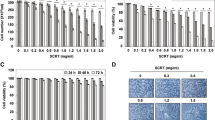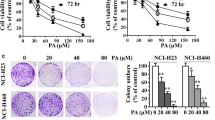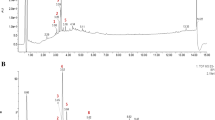Abstract
Magnolol, a hydroxylated biphenyl agent isolated from herbal planet Magnolia officinalis, is a component of traditional Asian herbal teas. It has been reported to have anti-microbial, anti-inflammatory, and anti-cancer activity. Non-small cell lung cancer (NSCLC) cell lines (A549, H441 and H520) and normal human bronchial epithelial cells (HBECs) were used to evaluate the cytotoxic effect of magnolol. We show that magnolol inhibited cellular proliferation, increased DNA fragmentation, and decreased mitochondrial membrane potential in all NSCLC cells, but had no cytotoxic effect on HBECs. Magnolol triggered the release of pro-apoptotic proteins: Bid, Bax and cytochrome c from mitochondria, but did not activate the caspase-3, -8, and -9, suggesting that magnolol induces apoptosis of NSCLC cell lines via a caspase-independent pathway. The caspase-independent pathway is mediated through the activation of nuclear translocation of apoptosis-inducing factor, endonuclease G and cleaved poly(ADP-ribose) polymerase, which played important roles in mediating cell death. Furthermore, magnolol inhibited PI3K/AKT and ERK1/2 activity, but up-regulated p38 and JNK activity in A549 cell lines. The results of this study provided a basis for understanding and developing magnolol as a novel treatment of NSCLC.






Similar content being viewed by others
References
Abd El-Aty, A.M., S.S. Shah, B.M. Kim, J.H. Choi, H.J. Cho, Y. Hee, B.J. Chang, H.C. Shin, K.B. Lee, M. Shimoda, and J.H. Shim. 2008. In vitro inhibitory potential of decursin and decursinol angelate on the catalytic activity of cytochrome P-450 1A1/2, 2D15, and 3A12 isoforms in canine hepatic microsomes. Archives of Pharmacal Research 31: 1425–1435.
Byeon, S.E., W.S. Choi, E.K. Hong, J. Lee, M.H. Rhee, H.J. Park, and J.Y. Cho. 2009. Inhibitory effect of saponin fraction from Codonopsis lanceolata on immune cell-mediated inflammatory responses. Archives of Pharmacal Research 32: 813–822.
Chang, C.P., Y.C. Hsu, and M.T. Lin. 2003. Magnolol protects against cerebral ischaemic injury of rat heatstroke. Clinical and Experimental Pharmacology and Physiology 30: 387–392.
Chen, Y.H., S.J. Lin, J.W. Chen, H.H. Ku, and Y.L. Chen. 2002. Magnolol attenuates VCAM-1 expression in vitro in TNF-alpha-treated human aortic endothelial cells and in vivo in the aorta of cholesterol-fed rabbits. British Journal of Pharmacology 135: 37–47.
Chen, Y.H., S.J. Lin, Y.L. Chen, P.L. Liu, and J.W. Chen. 2006. Anti-inflammatory effects of different drugs/agents with antioxidant property on endothelial expression of adhesion molecules. Cardiovascular and Hematological Disorders: Drug Targets 6: 279–304.
Chen, J.T., C.Y. Huang, Y.Y. Chiang, W.H. Chen, S.H. Chiou, C.Y. Chen, and K.C. Chow. 2008. HGF increases cisplatin resistance via down-regulation of AIF in lung cancer cells. American Journal of Respiratory Cell and Molecular Biology 38: 559–565.
Chen, X.W., K.B. Sneed, and S.F. Zhou. 2011. Pharmacokinetic profiles of anticancer herbal medicines in humans and the clinical implications. Current Medicinal Chemistry 18: 3190–3210.
Cheng, Y.L., S.C. Lee, H.J. Harn, H.C. Huang, and W.L. Chang. 2008. The extract of Hibiscus syriacus inducing apoptosis by activating p53 and AIF in human lung cancer cells. The American Journal of Chinese Medicine 36: 171–184.
Choi, Y.H., Y.W. Chin, and Y.G. Kim. 2011. Herb–drug interactions: Focus on metabolic enzymes and transporters. Archives of Pharmacal Research 34: 1843–1863.
Fried, L.E., and J.L. Arbiser. 2009. Honokiol, a multifunctional antiangiogenic and antitumor agent. Antioxidants and Redox Signaling 11: 1139–1148.
Gallego, M.A., B. Joseph, T.H. Hemstrom, S. Tamiji, L. Mortier, G. Kroemer, P. Formstecher, B. Zhivotovsky, and P. Marchetti. 2004. Apoptosis-inducing factor determines the chemoresistance of non-small-cell lung carcinomas. Oncogene 23: 6282–6291.
Gallego, M.A., C. Ballot, J. Kluza, N. Hajji, A. Martoriati, L. Castera, C. Cuevas, P. Formstecher, B. Joseph, G. Kroemer, C. Bailly, and P. Marchetti. 2008. Overcoming chemoresistance of non-small cell lung carcinoma through restoration of an AIF-dependent apoptotic pathway. Oncogene 27: 1981–1992.
Ganesan, V., and M. Colombini. 2010. Regulation of ceramide channels by Bcl-2 family proteins. FEBS Letters 584: 2128–2134.
Gottschling, S., P.A. Schnabel, F.J. Herth, and E. Herpel. 2012. Are we missing the target? Cancer stem cells and drug resistance in non-small cell lung cancer. Cancer Genomics and Proteomics 9: 275–286.
Grabb, M.C., and D.W. Choi. 1999. Ischemic tolerance in murine cortical cell culture: Critical role for NMDA receptors. Journal of Neuroscience 19: 1657–1662.
Greenberg, J.A., C.N. Boozer, and A. Geliebter. 2006. Coffee, diabetes, and weight control. The American Journal of Clinical Nutrition 84: 682–693.
Ha, H.C., and S.H. Snyder. 1999. Poly(ADP-ribose) polymerase is a mediator of necrotic cell death by ATP depletion. Proceedings of the National Academy of Sciences of the United States of America 96: 13978–13982.
Hong, S.J., T.M. Dawson, and V.L. Dawson. 2004. Nuclear and mitochondrial conversations in cell death: PARP-1 and AIF signaling. Trends in Pharmacological Sciences 25: 259–264.
Hsu, S.C., and J.G. Chung. 2012. Anticancer potential of emodin. Biomedicine 2: 108–116.
Huang, S.H., Y. Chen, P.Y. Tung, J.C. Wu, K.H. Chen, J.M. Wu, and S.M. Wang. 2007. Mechanisms for the magnolol-induced cell death of CGTH W-2 thyroid carcinoma cells. Journal of Cellular Biochemistry 101: 1011–1022.
Hung, Y.C., V.M. Sava, V.A. Blagodarsky, M.Y. Hong, and G.S. Huang. 2003. Protection of tea melanin on hydrazine-induced liver injury. Life Sciences 72: 1061–1071.
Hunter, T.B., N.J. Manimala, K.A. Luddy, T. Catlin, and S.J. Antonia. 2011. Paclitaxel and TRAIL synergize to kill paclitaxel-resistant small cell lung cancer cells through a caspase-independent mechanism mediated through AIF. Anticancer Research 31: 3193–3204.
Ikeda, K., and H. Nagase. 2002. Magnolol has the ability to induce apoptosis in tumor cells. Biological and Pharmaceutical Bulletin 25: 1546–1549.
Ikeda, K., Y. Sakai, and H. Nagase. 2003. Inhibitory effect of magnolol on tumour metastasis in mice. Phytotherapy Research 17: 933–937.
Jin, F.P., and M. Zhang. 2010. Progress of experimental researches on Chinese herbal compounds for inducing tumor cell apoptosis. Chinese Journal of Integrative Medicine 16: 565–571.
Joseph, B., J. Ekedahl, R. Lewensohn, P. Marchetti, P. Formstecher, and B. Zhivotovsky. 2001. Defective caspase-3 relocalization in non-small cell lung carcinoma. Oncogene 20: 2877–2888.
Kao, S.T., C.C. Yeh, C.C. Hsieh, M.D. Yang, M.R. Lee, H.S. Liu, and J.G. Lin. 2001. The Chinese medicine Bu–Zhong–Yi–Qi–Tang inhibited proliferation of hepatoma cell lines by inducing apoptosis via G0/G1 arrest. Life Sciences 69: 1485–1496.
Khanna, N., H.N. Jayaram, and N. Singh. 2004. Benzamide riboside induced mitochondrial mediated apoptosis in human lung cancer H520 cells. Life Sciences 75: 179–190.
Kondo, K., S. Obitsu, S. Ohta, K. Matsunami, H. Otsuka, and R. Teshima. 2010. Poly(ADP-ribose) polymerase (PARP)-1-independent apoptosis-inducing factor (AIF) release and cell death are induced by eleostearic acid and blocked by alpha-tocopherol and MEK inhibition. The Journal of Biological Chemistry 285: 13079–13091.
Konoshima, T., M. Kozuka, H. Tokuda, H. Nishino, A. Iwashima, M. Haruna, K. Ito, and M. Tanabe. 1991. Studies on inhibitors of skin tumor promotion, IX. Neolignans from Magnolia officinalis. Journal of Natural Products 54: 816–822.
Lee, S.J., Y.H. Cho, K. Park, E.J. Kim, K.H. Jung, S.S. Park, W.J. Kim, and S.K. Moon. 2008. Magnolol elicits activation of the extracellular signal-regulated kinase pathway by inducing p27KIP1-mediated G2/M-phase cell cycle arrest in human urinary bladder cancer 5637 cells. Biochemical Pharmacology 75: 2289–2300.
Lee, Y.K., D.Y. Yuk, T.I. Kim, Y.H. Kim, K.T. Kim, K.H. Kim, B.J. Lee, S.Y. Nam, and J.T. Hong. 2009. Protective effect of the ethanol extract of Magnolia officinalis and 4-O-methylhonokiol on scopolamine-induced memory impairment and the inhibition of acetylcholinesterase activity. Journal of Natural Medicines 63: 274–282.
Lee, Y.J., Y.M. Lee, C.K. Lee, J.K. Jung, S.B. Han, and J.T. Hong. 2011. Therapeutic applications of compounds in the Magnolia family. Pharmacology and Therapeutics 130: 157–176.
Li, H.B., X. Yi, J.M. Gao, X.X. Ying, H.Q. Guan, and J.C. Li. 2007. Magnolol-induced H460 cells death via autophagy but not apoptosis. Archives of Pharmacal Research 30: 1566–1574.
Lin, S.Y., Y.T. Chang, J.D. Liu, C.H. Yu, Y.S. Ho, Y.H. Lee, and W.S. Lee. 2001. Molecular mechanisms of apoptosis induced by magnolol in colon and liver cancer cells. Molecular Carcinogenesis 32: 73–83.
Liu, J.C., F.L. Hsu, J.C. Tsai, P. Chan, J.Y. Liu, G.N. Thomas, B. Tomlinson, M.Y. Lo, and J.Y. Lin. 2003. Antihypertensive effects of tannins isolated from traditional Chinese herbs as non-specific inhibitors of angiotensin converting enzyme. Life Sciences 73: 1543–1555.
Liu, Z., L. Ma, and G.B. Zhou. 2011. The main anticancer bullets of the Chinese medicinal herb, thunder god vine. Molecules 16: 5283–5297.
Lung, F.D., and J.Y. Tsai. 2003. Grb2 SH2 domain-binding peptide analogs as potential anticancer agents. Biopolymers 71: 132–140.
Mansi, L., A. Thiery-Vuillemin, T. Nguyen, F. Bazan, F. Calcagno, J. Rocquain, M. Demarchi, C. Villanueva, T. Maurina, and X. Pivot. 2010. Safety profile of new anticancer drugs. Expert Opinion on Drug Safety 9: 301–317.
Mantovani, A., C. Garlanda, and P. Allavena. 2010. Molecular pathways and targets in cancer-related inflammation. Annals of Medicine 42: 161–170.
Martinou, J.C., and R.J. Youle. 2011. Mitochondria in apoptosis: Bcl-2 family members and mitochondrial dynamics. Developmental Cell 21: 92–101.
Nakazawa, T., T. Yasuda, and K. Ohsawa. 2003. Metabolites of orally administered Magnolia officinalis extract in rats and man and its antidepressant-like effects in mice. The Journal of Pharmacy and Pharmacology 55: 1583–1591.
Oliver, F.J., G. De La Rubia, V. Rolli, M.C. Ruiz-Ruiz, G. De Murcia, and J.M. Murcia. 1998. Importance of poly(ADP-ribose) polymerase and its cleavage in apoptosis. Lesson from an uncleavable mutant. The Journal of Biological Chemistry 273: 33533–33539.
Rasul, A., B. Yu, M. Khan, K. Zhang, F. Iqbal, T. Ma, and H. Yang. 2012. Magnolol, a natural compound, induces apoptosis of SGC-7901 human gastric adenocarcinoma cells via the mitochondrial and PI3K/AKT signaling pathways. International Journal of Oncology 40: 1153–1161.
Robinson, K.S., A. Clements, A.C. Williams, C.N. Berger, and G. Frankel. 2011. Bax inhibitor 1 in apoptosis and disease. Oncogene 30: 2391–2400.
Seo, J.U., M.H. Kim, H.M. Kim, and H.J. Jeong. 2011. Anticancer potential of magnolol for lung cancer treatment. Archives of Pharmacal Research 34: 625–633.
Shen, J.L., K.M. Man, P.H. Huang, W.C. Chen, D.C. Chen, Y.W. Cheng, P.L. Liu, M.C. Chou, and Y.H. Chen. 2010. Honokiol and magnolol as multifunctional antioxidative molecules for dermatologic disorders. Molecules 15: 6452–6465.
Shu, L., K.L. Cheung, T.O. Khor, C. Chen, and A.N. Kong. 2010. Phytochemicals: Cancer chemoprevention and suppression of tumor onset and metastasis. Cancer Metastasis Reviews 29: 483–502.
Tang, F.Y. 2012. The silver bullet for cancer prevention: Chemopreventive effects of carotenoids. Biomedicine 2: 117–121.
Weiss, A., R.L. Wiskocil, and J.D. Stobo. 1984. The role of T3 surface molecules in the activation of human T cells: A two-stimulus requirement for IL 2 production reflects events occurring at a pre-translational level. Journal of Immunology 133: 123–128.
Xia, Z., M. Dickens, J. Raingeaud, R.J. Davis, and M.E. Greenberg. 1995. Opposing effects of ERK and JNK–p38 MAP kinases on apoptosis. Science 270: 1326–1331.
Yang, S.E., M.T. Hsieh, T.H. Tsai, and S.L. Hsu. 2003. Effector mechanism of magnolol-induced apoptosis in human lung squamous carcinoma CH27 cells. British Journal of Pharmacology 138: 193–201.
Yin, M.C. 2013. Humans and cancer: An ongoing fight. Biomedicine 2: 83.
You, Q., M. Li, and G. Jiao. 2009. Magnolol induces apoptosis via activation of both mitochondrial and death receptor pathways in A375-S2 cells. Archives of Pharmacal Research 32: 1789–1794.
Zakeri, Z., and R.A. Lockshin. 2008. Cell death: History and future. Advances in Experimental Medicine and Biology 615: 1–11.
Acknowledgments
This study was supported in part by the Grants KMUH9-9M63 and KMUH9-9M64 from Kaohsiung Medical University, the Grants NSC 100-2320-B-037-009, NSC 99-2221-E-037-006-MY3 and NSC 102-2320-B-039-025 from National Science Council, and Grant DOH102-TD-B-111-004 from Taiwan Department of Health Clinical Trial and Research Center of Excellence.
Conflict of interest
The authors declare they have no conflict of interest.
Author information
Authors and Affiliations
Corresponding author
Electronic supplementary material
Below is the link to the electronic supplementary material.
Rights and permissions
About this article
Cite this article
Tsai, JR., Chong, IW., Chen, YH. et al. Magnolol induces apoptosis via caspase-independent pathways in non-small cell lung cancer cells. Arch. Pharm. Res. 37, 548–557 (2014). https://doi.org/10.1007/s12272-013-0232-1
Received:
Accepted:
Published:
Issue Date:
DOI: https://doi.org/10.1007/s12272-013-0232-1




